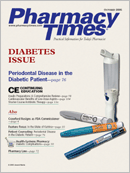Publication
Article
Pharmacy Times
Diabetic Complications: Are Your Patients at Risk?
Author(s):
Diabetes is the most significantmetabolic disorder facing theUnited States and the worldtoday. In fact, by the year 2025, it isestimated that >250 million personsthroughout the world will have diabetes.1 In the United States, theincrease has been at a rate of >30% inthe past 10 years.2 Such an increase isalarming, considering that it signals asimultaneous rise in the complicationsassociated with diabetes. Most patientsnewly diagnosed with diabetes havehad the disease for an average of 5years before an official diagnosis wasmade. The complications associatedwith diabetes also have been developingfor 5 years on average.
Diabetes contributes to a higher rateof morbidity and mortality through avariety of concomitant complications.Individuals with diabetes are at higherrisk for heart disease, blindness, kidneyfailure, extremity amputations, andother chronic conditions. In 2002, thedirect and indirect medical expendituresattributable to diabetes were estimatedat $132 billion, with $24.6 billionalone spent on associated chroniccomplications.3 The systemic complicationsthat follow the onset of diabetesare the result of both macrovascularand microvascular changes in the body.Macrovascular changes affect the largeblood vessels and result in complicationsinvolving the coronary arteries,the cerebral vasculature, and the bloodsupply to the lower extremities. Microvascularchanges affect the small vesselsand result in complications such asthose involving the retina.
A triad of care—comprised of glycemicregulation, hypertension control,and lipid management—is the keyto reducing complications related todiabetes. A team of health care professionalsis needed to manage these complications,as well as strict complianceon the part of the patient.
Glycemic Control
Complications associated with diabetestypically start from poor glycemiccontrol. Therefore, strictglycemic control is paramount in thetreatment of diabetes. Many clinicaltrials have showcased the importanceof glycemic control by demonstratingconclusively that normalization, ornear-normalization, of blood glucosesubstantially delays, or in certain casesprevents, the vascular complicationsassociated with diabetes.4,5 The DiabetesControl and Complications Trial(DCCT) showed that intensively loweringthe hemoglobin A1C (A1C) significantlyreduced the incidence and rateof progression of common diabeticcomplications such as retinopathy,clinical neuropathy, and albuminuriain patients with type 1 diabetes. In thisstudy, the strict glycemic control grouphad a mean A1C of ~7%.4
The idea that strict glycemic controlis essential to reducing diabetic complicationswas further emphasized bythe UK Prospective Diabetes Study(UKPDS). This study demonstratedthat treatment regimens that reducedthe A1C to ~7% reduced long-termmicrovascular complications in patientswith type 2 diabetes.5 The DCCTand the UKPDS also demonstratedthat intensive glycemic control greatlyreduced the risk and progression ofretinopathy. These benefits come withsome disadvantages, however, such asweight gain and hypoglycemia fromincreased insulin availability.
The starting point for glycemic controlis the maintenance of preprandialglucose levels of between 80 and 120mg/dL and the reduction of the A1C to<7%.6 A patient-kept record of bloodglucose measurements is helpful indiagnosing diabetes and in identifyingwhen the patient is most in need oftighter blood glucose control.
Therapy for strict glycemic controlshould be individualized. Before medicationis initiated, lifestyle modification—including medical nutritiontherapy (MNT) and increased physicalactivity—should be considered as away to manage blood glucose.
The medication starting point forpatients with type 2 diabetes is the secretagogues—mainly the sulfoylureas—with the stepwise addition of abiguanide and/or a thiazolidinedioneas indicated. In general, insulin is thelast addition, when other therapieshave failed to help the type 2 patientobtain the blood glucose control neededor when it is known that the othertherapies will not yield the reductionnecessary. Therapy should be initiatedwith insulin in patients with type 1diabetes. Intensive blood glucose controlis crucial to the successful reductionof all of the complications associatedwith diabetes.
Hypertension
Although intensive glycemic controlis the initial leg in the triad, furtherprevention of both microvascularand macrovascular complications maybe achieved through adequate bloodpressure control. Several studies havedemonstrated that a reduction inblood pressure to <130/80 mm Hgresults in a decreased risk for stroke,myocardial infarction, kidney disease,and retinopathy.7
Patients should be treated for hypertensionif their blood pressure is>130/80 mm Hg in 2 separate measurementsabout 1 month apart. Also, apatient-kept record of daily bloodpressures is helpful when attemptingto diagnose high blood pressure.
The DASH [Dietary Approaches toStop Hypertension] diet showed that,in nondiabetic individuals, blood pressurecan be reduced by diet modification(increasing fresh fruits and vegetables,decreasing salt, and choosinglow-fat dairy products); by increasingactivity levels; and by smoking cessation.This approach can be applied tomost individuals and is a good startingpoint for blood pressure reduction indiabetic patients.8 It is unlikely,though, that a reduction of bloodpressure to <130/80 mm Hg will beobtained by lifestyle modificationalone, and, in most cases, medicationtherapy will need to be initiated.
The blood pressure-lowering effectsof an angiotensin-converting enzyme(ACE) inhibitor have been shown toimprove cardiovascular (CV) outcomesin high-CV-risk patients with orwithout previous CV events, hypertension,or microalbuminuria, andregardless of type of diabetes.9Nephropathy is most strongly associatedwith elevated blood pressure.Therefore, the reduction of blood pressureto <130/80 mm Hg is optimal forslowing its progression. ACE inhibitorsor angiotensin II receptor blockers areconsidered first-line agents for thetreatment of hypertension in diabeticpatients and have been shown to slowthe progression of nephropathy.10,11The UKPDS also demonstrated that a10/5-mm Hg reduction in blood pressurereduced the risk of deteriorationin visual acuity by 3 lines on an eyechart.12 Therefore, intensive glycemiccontrol and blood pressure reductionare important in reducing the progressionof retinopathy and the possiblecomplication of blindness.
An ACE inhibitor should be initiatedin patients with diabetes, unlessotherwise contraindicated. The "start-low-go-slow" approach should be usedwhen initiating any medication, especiallyantihypertensives, to avoidadverse drug reactions and to obtainthe lowest therapeutic dose. Patientswill need frequent monitoring until thelowest therapeutic dose is achieved. Ifthe patient cannot obtain good bloodpressure control with one medication,another medication from a differentclass can be added, such as a diuretic.These medications should be added ina stepwise fashion and titrated to amaximum therapeutic dose or untilthe blood pressure goal of <130/80mm Hg is obtained.
Lipids
Type 2 diabetes is associated with a2-to 4-fold excess risk of coronaryheart disease (CHD). Therefore, treatmentof lipid disorders is imperative.13Elevated lipids, including low-densitylipoprotein (LDL) and triglycerides,are responsible for the macrovascularcomplications associated with diabetes,such as heart attack and stroke.As evidenced by the growing obesityepidemic, macrovascular complicationsin patients often are present longbefore diabetes is diagnosed.
Experts disagree about which componentof the cholesterol panel to targetin order to reduce CV events. A fewclinical trials have attempted to clarifythis issue, but all have resulted inslightly different conclusions. It appearsfrom observational studies thathigh-density lipoprotein (HDL) maybe the most consistent predictor ofCHD in type 2 diabetic subjects, followedby triglycerides and total cholesterol.13 Strict glycemic control maycontribute to a reduction in triglyceridelevels but will not completelyeliminate the excess risk of CHD intype 2 diabetic patients.
The current guidelines indicate thatthe following goals are optimal for areduction in CV end points in diabeticpatients without previous CHD:LDL <100 mg/dL; HDL: for men, >40mg/dL, for women, >50 mg/dL; andtriglycerides <150 mg/dL. These guidelineshave been set forth in the NationalCholesterol Education Program.14 Thesegoals may be reached in mildly elevatedpatients (LDL >140 mg/dL) throughlifestyle modification, including MNTand increased physical activity. If thepatient has a high risk for CHD or anLDL level >25 mg/dL above the goal (ie,LDL >125 mg/dL), a provider maydecide to initiate medication therapyalong with lifestyle modification.Providers ought to start medication inpatients with LDL >160 mg/dL.
Statins, also known as 5-hydroxy-3-methylglutaryl-coenzyme A reductaseinhibitors, are the initial medicationsof choice, unless otherwise contraindicated.This class of medication providesa reduction in total cholesterol,LDL, and triglycerides, as well as anincrease in HDL. If patients cannotreach individual lipid panel goals,other classes of medications can beadded, such as the fibrates, for targetinghypertriglyceridemia; or a selectivecholesterol absorption inhibitor,which blocks intestinal absorption ofdietary and biliary cholesterol. Reductionof LDL cholesterol remainsthe initial target for dyslipidemia management.
The clinical triad of improvement inglycemic control, reduction of bloodpressure, and improvement in the lipidpanel is essential for the reduction ofall complications associated with diabetes.Controlling these factors willnot only reduce the morbidity andmortality associated with diabetes, butalso will provide a better quality of lifefor diabetic patients. A little preventivemedicine will go a long way in reducingfuture health care dollars for thetreatment of diabetic complications.
Dr. Muzyk is a clinical pharmacy specialistat the Portland VA Medical Center inPortland, Ore.
For a list of references, send a stamped,self-addressed envelope to: References Department,Attn. A. Stahl, Pharmacy Times, 241 Forsgate Drive,Jamesburg, NJ 08831; or send an e-mailrequest to: astahl@ascendmedia.com.

Newsletter
Stay informed on drug updates, treatment guidelines, and pharmacy practice trends—subscribe to Pharmacy Times for weekly clinical insights.






